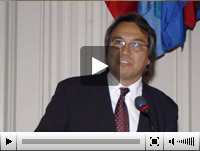- English
Cátedra de las Américas
Twenty Eighth Lecture - James Anaya
Twenty Eighth Lecture - April 17, 2008
“Indigenous Peoples and their Contribution to the International Human Rights System"
Orador:
James Anaya, Professor of Human Rights Law and Policy and U.N. Special Rapporteur on the Situation of Human Rights and Fundamental Freedoms of Indigenous Peoples
Today I’d like to talk about indigenous peoples and the contribution they have made to the international human rights system. These contributions have come about within the context of a worldwide indigenous movement, in which indigenous peoples have engaged states and international institutions in discussions about their aspirations to survive as distinct communities in control their own destinies. Powerful forces have long ignored these aspirations and, worse, have actively suppressed the bonds of community and connection with place that define indigenous peoples. The history of misdealing and atrocities committed against the indigenous peoples of the American continents ever since Christopher Columbus found himself on a Caribbean island, miscalculated his location, and called his hosts “Indians,” is well known.
Much less widely known among many are the present day legacies of this sad history and the steps indigenous peoples have been taking to reverse that history.
For indigenous peoples of the Americas and elsewhere, historical acts of oppression are not just blemishes of the past, but rather translate into current inequities. Peoples indigenous to many parts of the world have been deprived of vast landholdings and access to life-sustaining resources, and they have suffered historical forces that have actively suppressed their political and cultural institutions. As a result, indigenous peoples have been crippled economically and socially, their cohesion as communities has been damaged or threatened, and the integrity of their cultures has been undermined. In both industrial and less-developed countries in which indigenous people live, the indigenous sectors are almost invariably at the lowest rung of the socioeconomic ladder, and they exist at the margins of power.
In North America the myth of the “vanishing savage” was created to embolden white settlement. But his myth has only partially been embraced by reality. Although vastly reduced in numbers, and in many case concentrated in pockets of relative geographic isolation, the indigenous peoples of the American continent are still here, as we seen manifested by the many representatives of indigenous peoples at the OAS today. In the face of tremendous adversity, indigenous peoples have long sought not just to survive physically, but to flourish as distinct communities on their ancestral territories. They have endeavored to roll back the inequities that linger from the experiences of the past. This “blood struggle,” as the author and scholar Charles Wilkinson calls it in the title of his most recent book, is one that draws its major source of strength from the remarkable resilience of indigenous peoples and from the cultural and social patterns that bind them into communities.
Drawing on this strength, indigenous peoples have employed a number of strategies, including those that enlist the law and the legal processes of the world beyond their communities as agents of change. However, the limitations of the domestic legal orders of states that have emerged from colonial patterns, have all too often become apparent. Faced with legal and political barriers in their own countries, indigenous peoples worldwide have extended their legal advocacy into the international arena. Over the last three decades especially, they have been appealing to the international community and looking to the international legal system to advance their claims.
But the international legal system has its own set of limitations, which indigenous peoples have also had to confront. First and foremost, it is a system of rules, institutions, and procedures in which states are the primary actors and beneficiaries. Further, international law doctrine historically was complicit in patterns of colonization, ultimately upholding the sovereignty asserted by colonizing states over indigenous peoples and the suppression of their societies. But things change.
Since the middle of the twentieth century, the structure and normative parameters of international law and relations have evolved significantly. Contributing to among the most radical changes in the character of the international is the development of an international human rights regime. Human rights were brought definitely within the fold of the international legal system in the aftermath of World War II and the adoption of the charters of the United Nations and the Organization of American States. The growth of the human rights regime takes international law and policy beyond its traditional focus on the rights and duties of states, and establishes an international concern and legal competency over matters once deemed within the exclusive domain of states. Furthermore, the international human rights regime has provided individuals and other non-state actors with access, albeit limited, to avenues of international decision-making.
Indigenous peoples have seized upon the institutional and normative regime of human rights that now figures prominently within international law and politics. Responding to indigenous peoples’ demands is a human rights imperative that is now widely recognized within the international system, including the inter-American system.
And with this recognition has come a sustained level of international institutional activity focused upon indigenous peoples’ concerns and a corresponding body of developing norms that build upon long-standing human rights precepts. Just last year, on September 13 the United Nations General Assembly adopted the Declaration on Rights of Indigenous Peoples, affirming a constellation of rights grounded in the right of indigenous peoples to self-determination and calling on states and the international community to make these rights reality. This week, here at the OAS, negotiations are ongoing on the proposed American Declaration on the Rights of Indigenous Peoples in another important example of the international activity responsive to indigenous peoples’ demands.

